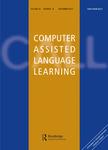版权所有:内蒙古大学图书馆 技术提供:维普资讯• 智图
内蒙古自治区呼和浩特市赛罕区大学西街235号 邮编: 010021

作者机构:Asia Univ Dept Early Childhood Educ Taichung Taiwan Griffith Univ Sch Language & Linguist Nathan Australia Natl Sun Yat sen Univ Dept Informat Management Kaohsiung Taiwan Natl Taiwan Normal Univ Inst Res Excellence Learning Sci Taipei Taiwan Natl Taiwan Normal Univ Program Learning Sci Taipei Taiwan
出 版 物:《COMPUTER ASSISTED LANGUAGE LEARNING》 (Comput. Assisted Lang. Learn.)
年 卷 期:2024年第37卷第7期
页 面:2142-2173页
核心收录:
学科分类:0502[文学-外国语言文学] 0401[教育学-教育学] 05[文学]
基 金:Ministry of Science and Technology, Taiwan [MOST 111-2410-H-003-028-MY3, MOST-109-2511-H-003-053-MY3, MOST-108-2511-H-003-061-MY3] Institute for Research Excellence in Learning Sciences' of National Taiwan Normal University (NTNU) from The Featured Areas Research Center Program by the Ministry of Education (MOE) in Taiwan
主 题:Learning support IoT-based tangible toys educational robot robot facilitate language learning
摘 要:Existing research has established immense importance in contextual learning for second language development. However, to provide real-life context in the learning of a foreign language is challenging. To help create such a learning environment, our previous research developed an innovative system called the R&T System, utilizing robots (R) and tangible objects (T) with Internet of Things (IoT sensors). As the R&T system is still new, there is no sufficient knowledge about what learning obstacles learners would encounter in such a context-rich environment and how best to support them. To explore these issues, in the current study, we designed an English vocabulary game to engage learners to interact with the R&T System. Adopting an action research methodology, we first conducted a pilot study with 12, fourth grade students to identify learning obstacles in a game setting. They were randomly assigned to two groups, one with learning support and the other without learning support. The experiment lasted for four weeks. Both pre-test and post-test on English vocabulary were used to measure the effectiveness of these learning support mechanisms. From the video recordings of the participants engagement with the R&T System, the results reveal that the learning support mechanisms had positive impact on the participants learning performance and significantly reduced the occurrences of learning obstacles. This research could serve as a useful reference for future research when designing learning support for contextual vocabulary learning supported by a robotic system.